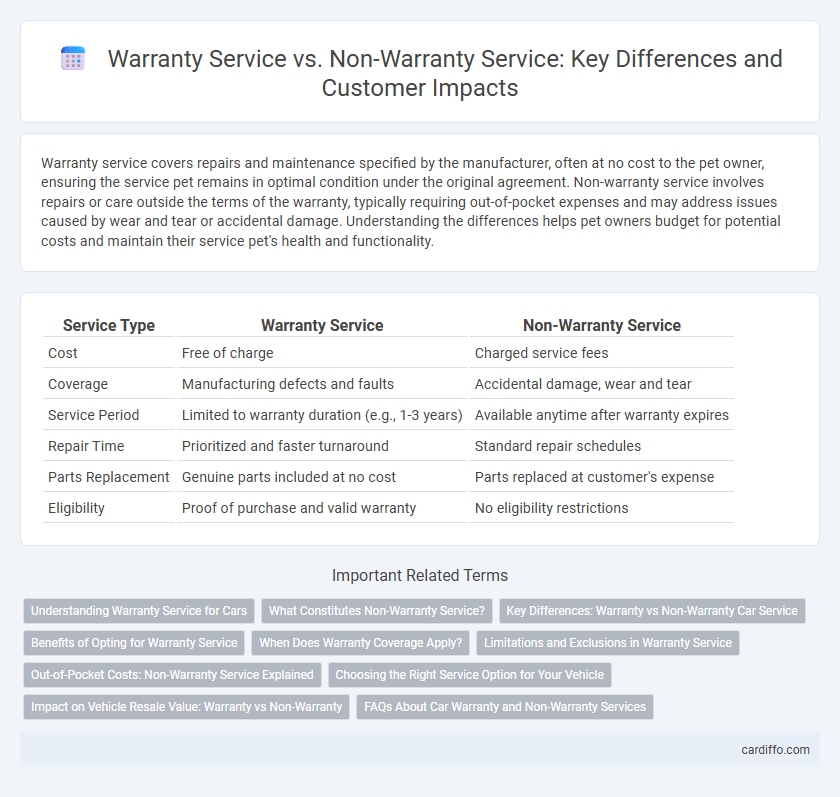Warranty service covers repairs and maintenance specified by the manufacturer, often at no cost to the pet owner, ensuring the service pet remains in optimal condition under the original agreement. Non-warranty service involves repairs or care outside the terms of the warranty, typically requiring out-of-pocket expenses and may address issues caused by wear and tear or accidental damage. Understanding the differences helps pet owners budget for potential costs and maintain their service pet's health and functionality.
Table of Comparison
| Service Type | Warranty Service | Non-Warranty Service |
|---|---|---|
| Cost | Free of charge | Charged service fees |
| Coverage | Manufacturing defects and faults | Accidental damage, wear and tear |
| Service Period | Limited to warranty duration (e.g., 1-3 years) | Available anytime after warranty expires |
| Repair Time | Prioritized and faster turnaround | Standard repair schedules |
| Parts Replacement | Genuine parts included at no cost | Parts replaced at customer's expense |
| Eligibility | Proof of purchase and valid warranty | No eligibility restrictions |
Understanding Warranty Service for Cars
Warranty service for cars covers repairs and replacements of vehicle components within the manufacturer's specified period, typically ranging from three to five years or a certain mileage limit such as 36,000 to 60,000 miles. This service includes parts and labor costs for defects resulting from manufacturing faults, ensuring cost-free maintenance for covered issues under the warranty terms. Understanding the scope of warranty service helps car owners avoid unexpected expenses by recognizing which repairs qualify for free coverage versus non-warranty services that require out-of-pocket payments.
What Constitutes Non-Warranty Service?
Non-warranty service refers to repairs or maintenance tasks performed outside the scope of the original product warranty, often involving parts or issues not covered by the manufacturer's terms. These services typically include wear-and-tear repairs, accidental damage, and modifications requested by the customer. Costs for non-warranty services are usually borne by the customer, as they fall beyond the contractual obligations of warranty coverage.
Key Differences: Warranty vs Non-Warranty Car Service
Warranty car service covers repairs and maintenance specified by the manufacturer within a predetermined time or mileage, ensuring costs are typically borne by the automaker. Non-warranty service involves repairs or maintenance outside the warranty terms, requiring out-of-pocket expenses from the vehicle owner. Key differences include coverage eligibility, cost responsibility, and the scope of services authorized under warranty agreements.
Benefits of Opting for Warranty Service
Warranty service offers significant cost savings by covering repairs and replacements within the warranty period, eliminating out-of-pocket expenses for consumers. It ensures access to authorized technicians who use genuine parts, maintaining product quality and performance. Opting for warranty service enhances peace of mind through reliable support and faster resolution times, compared to non-warranty service options.
When Does Warranty Coverage Apply?
Warranty coverage applies when the product or service issue occurs within the specified warranty period and pertains to defects in materials or workmanship as outlined in the warranty terms. Non-warranty service applies to repairs or maintenance caused by user damage, wear and tear, or issues arising outside the warranty timeframe. Understanding the warranty conditions ensures customers receive eligible free repairs while non-warranty services involve additional fees for service costs and parts replacement.
Limitations and Exclusions in Warranty Service
Warranty service covers repairs or replacements only for defects arising from manufacturing or workmanship within the specified warranty period, excluding damages caused by accidents, misuse, unauthorized alterations, or normal wear and tear. Limitations in warranty service often include geographic restrictions, required proper maintenance, and the necessity of presenting proof of purchase. Non-warranty service, by contrast, addresses all other repairs but typically incurs charges for parts and labor.
Out-of-Pocket Costs: Non-Warranty Service Explained
Non-warranty service requires customers to cover all repair or maintenance costs out of pocket, including parts, labor, and diagnostic fees, which are not reimbursed by the manufacturer. These services typically apply when the vehicle or product warranty has expired or the issue falls outside warranty terms, making expenses potentially higher than warranty-covered repairs. Understanding the financial implications of non-warranty service helps consumers budget effectively and avoid unexpected expenses.
Choosing the Right Service Option for Your Vehicle
Selecting between warranty service and non-warranty service depends on your vehicle's coverage status and repair needs. Warranty service offers cost-effective repairs covered under the manufacturer's agreement, ensuring genuine parts and certified technicians. Non-warranty service provides flexibility for out-of-warranty vehicles, often at a higher cost, but allows for customized maintenance and repair options beyond factory terms.
Impact on Vehicle Resale Value: Warranty vs Non-Warranty
Warranty service maintains detailed repair records and certified parts usage, which enhances a vehicle's resale value by assuring buyers of proper maintenance and manufacturer-backed repairs. Non-warranty service may lead to inconsistent service documentation and the use of aftermarket parts, potentially decreasing buyer confidence and lowering resale prices. Vehicles with comprehensive warranty service histories typically command higher market values compared to those with predominantly non-warranty repairs.
FAQs About Car Warranty and Non-Warranty Services
Car warranty services cover repairs and parts replacement under the manufacturer's specified period, typically ranging from 3 to 7 years or 36,000 to 100,000 miles, ensuring no cost for defects or faulty workmanship. Non-warranty services include routine maintenance, wear-and-tear repairs, and any fixes outside the warranty scope, often charged directly to the vehicle owner. Common FAQs address coverage details, claim procedures, exclusions like accidental damage, and the importance of keeping service records to maintain warranty validity.
Warranty Service vs Non-Warranty Service Infographic

 cardiffo.com
cardiffo.com